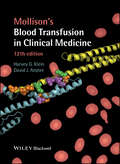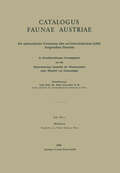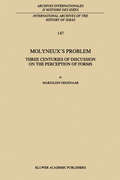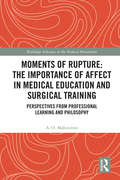- Table View
- List View
Molekularmedizinische Grundlagen von fetalen und neonatalen Erkrankungen (Molekulare Medizin)
by Roland R. WauerDer vorliegende Band der Buchreihe Molekulare Medizin spannt einen großen Bogen von ethischen Problemen, die sich ergeben aus der Anwendung der pränatalen Diagnostik und der Präimplantationsdiagnostik, bis hin zu molekularen Ursachen von Hauterkrankungen. Der aktuelle Stand der molekularmedizinischen Erkenntnisse in der Pränatalmedizin und Pädiatrie wird ausführlich dargelegt, wobei der neonatalen Infektabwehr sowie der Erörterung der Ursachen von Herz-/Kreislauferkrankungen sowie Erkrankungen des Atmungssystems breiter Raum gewidmet wird.
Molekularmedizinische Grundlagen von hämatologischen Neoplasien (Molekulare Medizin)
by Brigitte Schlegelberger Christa FonatschDer Überblick umfasst hereditäre Erkrankungen mit erhöhtem Risiko für hämatologische Neoplasien sowie sporadische hämatologische Neoplasien, Leukämien und Lymphome. Experten informieren Sie praxisbezogen über die molekularmedizinischen Ursachen und deren Einfluss auf Diagnose und Therapie.
Molekularmedizinische Grundlagen von hereditären Tumorerkrankungen (Molekulare Medizin)
by S. A. Hahn W. SchmiegelDie Entwicklungen in der Molekularbiologie, neue gentechnische Methoden und die Entschlüsselung des menschlichen Genoms revolutionieren die Krebsforschung. Durch die moderne Gendiagnostik hat insbesondere die Früherkennung hereditärer Tumore entscheidende Fortschritte gemacht.Anerkannte Experten vermitteln Ihnen praxisorientiert die aktuellen Erkenntnisse über die molekularen Ursachen von hereditären Krebserkrankungen.In diesem Handbuch finden Sie:- neueste Forschungsergebnisse ausführlich interpretiert- gentechnische Methoden verständlich erklärt- diagnostische und therapeutische Möglichkeiten im Überblick- molekularmedizinische und konventionelle Therapien im Vergleich- sichere Orientierung in der klinischen Praxis und ForschungIhr Wissensvorsprung auf einem zukunftsweisenden Gebiet der Medizin!
Molekularmedizinische Grundlagen von nicht-hereditären Tumorerkrankungen (Molekulare Medizin)
by S. Hahn W. SchmiegelMit einer Rate zwischen 85% und 95% kommen nicht-hereditäre Tumorerkrankungen um ein Vielfaches häufiger vor als hereditäre. Nicht-erbliche Tumorerkrankungen betreffen besonders Organe, die starken Belastungen durch Schadstoffe ausgesetzt sind. Der pleiotrope Charakter dieser Erkrankungen erfordert eine komplizierte Diagnostik, um die Ursachen zu klären.Der Band vermittelt Ihnen praxisorientiert den neuesten Wissensstand über die molekularen Ursachen dieser Erkrankungen - Erkenntnisse, die Ihnen grundlegende Orientierungshilfen bieten.
Molekularmedizinische Grundlagen von para- und autokrinen Regulationsstörungen (Molekulare Medizin)
by Josef KöhrleIm vorliegenden Band stehen lokal wirksame Hormonsysteme, Gewebshormone, ihre auto-, para- und intrakrinen Funktionen sowie ihre Störungen als Ursache von Erkrankungen im Mittelpunkt der Darstellung. Namhafte Experten haben hundert Jahre nach der Einführung des Hormonbegriffes durch Starling 1905 den gegenwärtigen Wissensstand in 25 Kapiteln zusammengeführt, der dem interessierten Leser eine umfassende Orientierung über dieses interdisziplinäre Fachgebiet erlaubt.
Molekularmedizinische Grundlagen von rheumatischen Erkrankungen (Molekulare Medizin)
by Steffen Gay Jochen R. KaldenDas Buch mit namhaften Autoren soll Medizinstudenten und Allgemeinmedizinern ebenso wie niedergelassenen und klinisch tätigen Internisten und Rheumatologen den derzeitigen Wissensstand über molekulare und zelluläre Grundlagen rheumatischer Erkrankungen und den sich daraus entwickelnden Therapieprinzipien vermitteln.
Molekularpathologie (Sitzungsberichte der Heidelberger Akademie der Wissenschaften #1975 / 1)
by M. RatzenhoferMoller's Essentials of Pediatric Cardiology
by Walter H. Johnson Camden L. HebsonHighly useful guide for all members of a multidisciplinary team managing children suffering from heart disease Built on the success of previous editions and brought to you by a stellar author team, Moller’s Essentials of Pediatric Cardiology, 4th Edition provides a unique, concise, and extremely practical overview of heart disease in children. From history-taking, physical examination, ECG, and chest X-ray—the basics that enable clinicians to uncover possible problems and eliminate areas of false concern—this work goes on to examine the range of more complex topics in the diagnosis and treatment/management of childhood cardiovascular disease. Every chapter is fully updated with the very latest clinical guidelines and management options from the AHA, ACC, and ESC. Recent updates also include an enhanced section on imaging, including recent advances in cardiac MRI and fetal echocardiography, new techniques in genetic testing for heart disease in special populations, and much more emphasis on the importance of echocardiography in understanding the pathophysiology of congenital cardiac malformations. This work also includes an expanded section on cardiac conditions in the neonate, specifically on prenatal diagnosis and management, and neonatal screening for congenital heart disease. Moller’s Essentials of Pediatric Cardiology, 4th Edition also provides: Tools to diagnose cardiac conditions in children and environmental and genetic conditions associated with heart disease in children Anomalies with a left-to-right shunt in children, conditions obstructing blood flow in children, and congenital heart disease with a right-to-left shunt in children Unusual forms of congenital heart disease in children, unique cardiac conditions in newborn infants, and the cardiac conditions acquired during childhood Abnormalities of heart rate and conduction in children and congestive heart failure in infants and children Moller’s Essentials of Pediatric Cardiology, 4th Edition is a succinct and accessible yet highly detailed and informative resource for treating children suffering from heart disease. It is an invaluable reference for anyone working on a multidisciplinary team treating patients with these attributes.
Moller's Essentials of Pediatric Cardiology
by Walter H. Johnson Camden L. HebsonHighly useful guide for all members of a multidisciplinary team managing children suffering from heart disease Built on the success of previous editions and brought to you by a stellar author team, Moller’s Essentials of Pediatric Cardiology, 4th Edition provides a unique, concise, and extremely practical overview of heart disease in children. From history-taking, physical examination, ECG, and chest X-ray—the basics that enable clinicians to uncover possible problems and eliminate areas of false concern—this work goes on to examine the range of more complex topics in the diagnosis and treatment/management of childhood cardiovascular disease. Every chapter is fully updated with the very latest clinical guidelines and management options from the AHA, ACC, and ESC. Recent updates also include an enhanced section on imaging, including recent advances in cardiac MRI and fetal echocardiography, new techniques in genetic testing for heart disease in special populations, and much more emphasis on the importance of echocardiography in understanding the pathophysiology of congenital cardiac malformations. This work also includes an expanded section on cardiac conditions in the neonate, specifically on prenatal diagnosis and management, and neonatal screening for congenital heart disease. Moller’s Essentials of Pediatric Cardiology, 4th Edition also provides: Tools to diagnose cardiac conditions in children and environmental and genetic conditions associated with heart disease in children Anomalies with a left-to-right shunt in children, conditions obstructing blood flow in children, and congenital heart disease with a right-to-left shunt in children Unusual forms of congenital heart disease in children, unique cardiac conditions in newborn infants, and the cardiac conditions acquired during childhood Abnormalities of heart rate and conduction in children and congestive heart failure in infants and children Moller’s Essentials of Pediatric Cardiology, 4th Edition is a succinct and accessible yet highly detailed and informative resource for treating children suffering from heart disease. It is an invaluable reference for anyone working on a multidisciplinary team treating patients with these attributes.
Mollison's Blood Transfusion in Clinical Medicine
by Harvey G. Klein David J. AnsteeMollison's Blood Transfusion in Clinical Medicine is an icon in the field of transfusion and the first edition was published in 1951. The book arose from the concept of the transfusionist, as both scientist and expert consultant. For many years, this text has provided the primary, and often the sole, reference for detailed information and practical experience in blood transfusion. The book is completely revised and updated throughout to include the latest advances and developments in the field.
Mollison's Blood Transfusion in Clinical Medicine
by Harvey G. Klein David J. AnsteeMollison's Blood Transfusion in Clinical Medicine is an icon in the field of transfusion and the first edition was published in 1951. The book arose from the concept of the transfusionist, as both scientist and expert consultant. For many years, this text has provided the primary, and often the sole, reference for detailed information and practical experience in blood transfusion. The book is completely revised and updated throughout to include the latest advances and developments in the field.
Mollison's Blood Transfusion in Clinical Medicine
by Harvey G. Klein David J. Anstee“Both authors have dealt in an authoritative way with the still rapidly expanding specialty and the eleventh edition of the book will be of the greatest value to all who are interested in the scientific and practical aspects of blood transfusion in clinical medicine.” From the Foreword by Professor P.L. Mollison Highly respected, long-established book that has become the "bible" in transfusion medicine Why Buy This Book? Provides a sound basis for understanding modern transfusion medicine Definitive reference source for any clinician involved with patients requiring transfusion and for all staff working in transfusion services, immunohaematology laboratories and blood banks Highly practical advice on management issues for the clinician Completely revised and updated to reflect the rapid pace of change in transfusion medicine Written by two of the world's leading experts in the field
Molluscan Shellfish Safety
by Gilbert SauvéIn a time of rapid climatic, industrial and technological changes in molluscan shellfish producing and exporting regions, it is of the utmost importance to keep a keen eye on developing trends. This collection of recent research in molluscan shellfish safety, risk assessment, risk management, regulation and analytical methods presented at the 8th ICMSS (International Conference on Molluscan Shellfish Safety) offers valuable insights in the latest scientific findings. Dans le contexte actuel de changements climatiques, industriels et technologiques rapides dans les régions qui produisent et qui exportent des mollusques, il est essentiel de rester à l’affût des nouvelles tendances. Ce recueil des récents travaux de recherche dans les domaines de la salubrité des mollusques, des évaluations des risques, de la gestion des risques, de la réglementation et des méthodes d’analyse présentés lors de la 8e Conférence internationale sur la salubrité des coquillages (ICMSS) vous aidera à le faire.
Molluscs: From Chemo-ecological Study to Biotechnological Application (Progress in Molecular and Subcellular Biology #43)
by Guido Cimino Margherita GavagninThis is the first book on molluscs as sources for pharmaceutical drugs. Marine molluscs are very promising candidates for a wide range of biotechnological applications. For example, they possess analgesic drugs more potent than morphine and very effective anticancer agents. International experts provide coverage of the most stimulating topics related to molluscs. This knowledge of their history and current studies opens the door to the future.
Moloy's Evaluation of the Pelvis in Obstetrics
by Charles SteerT HE prediction of the probability of the safe passage of the fetus through the birth canal is the primary function of the attendant at the start of labor. The means of determining the relative size of the fetal head and the internal diameters of the pelvis have therefore been the objects of deep concern down through the centuries. Manual techniques of clinical evaluation of cephalo-pelvic relations reached their peak a generation or two ago. A massive nomenclature existed with respect to pelvic planes and diam eters. To these were related various positions, attitudes, stations, and synclitisms of the fetal head. Measurements depended on digital efforts to explore the interior and on dubious implications drawn from external pelvimetry. The mechanisms of labor, as it might occur under the innumerable possible pelvic measure ments and fetal orientations, were the subject of hours of stu dent drilling and remained a lifelong preoccupation of the most seasoned specialist. The increasing safety of cesarean section somewhat miti gated the consequences of error. When a borderline internal conjugate was digitally determined, a trial labor might be per mitted with the assurance that an ultimate solution was in reserve. Mistakes of two kinds persisted, however. On the one hand, trial labor might be permitted to continue too long and, with penicillin not yet discovered, a delayed cesarean section v vi Foreword could be perilous. Alternately, to be on the safe side, many un necessary elective sections might be carried out.
Molyneux’s Problem: Three Centuries of Discussion on the Perception of Forms (International Archives of the History of Ideas Archives internationales d'histoire des idées #147)
by M. DegenaarSuppose that a congenitally blind person has learned to distinguish and name a sphere and a cube by touch alone. Then imagine that this person suddenly recovers the faculty of sight. Will he be able to distinguish both objects by sight and to say which is the sphere and which the cube? This was the question which the Irish politician and scientist William Molyneux posed in 1688 to John Locke. Molyneux's question has intrigued a wide variety of intellectuals for three centuries. Those who have attempted to solve it include Berkeley, Reid, Leibniz, Voltaire, La Mettrie, Condillac, Diderot, Müller, Helmholtz, William James and Gareth Evans. This book is the first comprehensive survey of the history of the discussion about Molyneux's problem. It will be of interest to historians of both philosophy and psychology.
Moments of Rupture: Perspectives from Professional Learning and Philosophy (Routledge Advances in the Medical Humanities)
by A. O. MahendranSurgery is a craft specialty: ‘doing’ in response to what is seen, felt and anticipated. The potent odours and the raw images of flesh, elicit strong sensations and responses in the here-and-now or ‘thisness’ (haecceities) of practice. These experiences, trigger a world of affects and senses that can disturb or rupture familiar or established ways of thinking and knowing. This book attempts to articulate these emotional complexities of learning and practice by exploring affective encounters with the uncertainty of medical events. Employing a practice based inquiry, grounded in philosophical notions of affect and related concepts, real stories of actual practice are analysed and theorised to examine how events of clinical practice come to matter or become meaningful to surgeons, potentially disclosing new or modified capacities to see, think, understand and act. The philosophical writings of Alfred North Whitehead, Gilles Deleuze, Gilbert Simondon and Brian Massumi inform the exploration. The critical discussions of this book are relevant for healthcare professionals, medical educators, practitioners and researchers interested in its main exploration: the affective conditions that emerge from disturbances in practice and their power to shape, construct and transform how professionals understand their practice and function within it.
Moments of Rupture: Perspectives from Professional Learning and Philosophy (Routledge Advances in the Medical Humanities)
by A. O. MahendranSurgery is a craft specialty: ‘doing’ in response to what is seen, felt and anticipated. The potent odours and the raw images of flesh, elicit strong sensations and responses in the here-and-now or ‘thisness’ (haecceities) of practice. These experiences, trigger a world of affects and senses that can disturb or rupture familiar or established ways of thinking and knowing. This book attempts to articulate these emotional complexities of learning and practice by exploring affective encounters with the uncertainty of medical events. Employing a practice based inquiry, grounded in philosophical notions of affect and related concepts, real stories of actual practice are analysed and theorised to examine how events of clinical practice come to matter or become meaningful to surgeons, potentially disclosing new or modified capacities to see, think, understand and act. The philosophical writings of Alfred North Whitehead, Gilles Deleuze, Gilbert Simondon and Brian Massumi inform the exploration. The critical discussions of this book are relevant for healthcare professionals, medical educators, practitioners and researchers interested in its main exploration: the affective conditions that emerge from disturbances in practice and their power to shape, construct and transform how professionals understand their practice and function within it.
Moments of Truth in Genetic Medicine
by M. Susan LindeeGenetic research increasingly dominates medical thought and practice in the United States and in many other industrialized nations. Susan Lindee's original study explores the institutions, disciplines, and ideas that initiated the reconfiguration of genetic medicine from a marginal field in the mid-1950s to a core research frontier of biomedicine. Tracing the work of geneticists and other experts in identifying and classifying disease during the explosive period between 1950 and 1980, Lindee identifies the individual "moments of truth" that moved the field away from its eugenic past to the center of a new world view in which nearly all disease is understood to be fundamentally genetic. She suggests that these moments of truth were experienced not only by scientists but also by those who had familial, intimate, emotional knowledge of hereditary disease: patients, family members, and research subjects. Focusing on benchmarks in the field—such as the rise of neonatal testing in the 1960s, genetic studies of unique human populations such as the Amish, the development of human cytogenetics and human behavioral genetics, and the efforts to find genes for rare diseases such as familial dysautonomia—she tracks the emergence of a biomedical consensus that nearly all disease is genetic disease. Using the success of this field as a point of entry, Lindee chronicles both the production of knowledge in biomedicine and changes in the cultural meaning of the body in the late twentieth century. She suggests that scientific knowledge is a community project that is shaped directly by people in many different social and professional locations. The power to experience and report scientific truth may be much more dispersed than it sometimes appears, because people know things about their own bodies, and their knowledge has often been incorporated into the technical infrastructure of genomic medicine. Lindee's pathbreaking study shows the interdependence of technical and social parameters in contemporary biomedicine.
Momordica genus in Asia - An Overview
by L.K. Bharathi K Joseph JohnAsiatic Momordica comprises 10 species of which 3 are monoecious and rest dioecious. They are unique in the sense that all are wild or cultivated vegetables with medicinal uses. Barring bitter gourd, all are under utilized vegetables with little research and conservation efforts. In this book, the authors have presented the available information on various aspects of Asiatic Momordica like taxonomy, cytogenetics, crop improvement, origin, ethnobotany and crop production at one place. The book is well illustrated with color maps and photographs depicting habit, morphology and distribution of individual taxa. Species distribution map for all Indian taxa, descriptor for characterization and preliminary evaluation of dioecious and monoecious group available varieties, keys for botanical identification are some of the unique features of the book. The book will be useful to botanists, horticulturists, foresters, environment educators, conservation biologists, plant science students in general and all interested in agrobiodiversity.
Mon Amour trifft Pretty Woman: Liebespaare im Film
by Stephan Doering Heidi MöllerDie Liebe stellt das Kultur- und Menschheitsthema schlechthin dar, so ist es auch kein Wunder, dass kein anderes Sujet im Film einen vergleichbaren Stellenwert einnimmt. Ebenso wie in der Literatur sind es immer wieder die klassischen dramatischen Motive wie Eifersucht, Trennung, unerfüllte Liebe, verbotene Liebe, Liebestod oder auch die Spannung von Liebe und Sex, die im Spielfilm abgehandelt werden. Während der triviale Liebesfilm lediglich Klischees der klassischen Motive liefert, finden sich in anspruchsvolleren Filmen differenzierte Darstellungen der psychologischen Entwicklung eines Paares, der individuellen Paardynamik. Psychologische und psychoanalytische Konzepte können helfen, Paare und ihre Liebesbeziehungen zu verstehen: Was tragen die individuellen Lebensgeschichten und Erfahrungen zur Paarbeziehung bei? Welcher Paarkonflikt verhindert das Gelingen der Liebe? Was lässt zwei Menschen füreinander in Liebe entbrennen? Was sind die Voraussetzungen für eine erfüllte Liebe? Dieses Buch enthält über 30 Analysen von Liebespaaren aus verschiedenen Spielfilmen. Das Spektrum reicht vom Klassiker bis hin zu aktuellen Werken aus den letzten Jahren.
Monatsschrift Kinderheilkunde: Organ der Deutschen Gesellschaft für Kinderheilkunde
by K. D. Bachmann H. Berger J. Bierich D. Boda H.-J. Bremer J. Brodehl G. R. Burgio K. Fischer E. Gladtke B. Hadorn B. Hagberg N. Hallman H. G. Hansen H. Harbauer G.-A. von Harnack W. C. Hecker H. Helge W. H. Hitzig E. Huth E. Kleihauer W. Künzer M. A. Lassrich B. Leiber B. Lindquist W. Marget J. Oehme H. Olbing R. A. Pfeiffer A. Prader K. Riegel E. Rossi K. Schärer E. Schmidt F.-J. Schulte H. Spiess J. Spranger G. Stalder U. Stephan J. Stoermer J. Ströder W. Teller R. Zetterström E. ZweymüllerMond- en kaakziekten: Een atlas voor de dagelijkse praktijk
by I. van der WaalDit boek geeft een praktijkgericht overzicht van de pathologie van het mondgebied. Het beschrijft kernachtig de aandoeningen in en rond de mond. Deze aandoeningen komen voor op het mondslijmvlies, de speekselklieren, in het kaakbot, op de tong, het gehemelte en de lippen. Het boek bevat veel duidelijke afbeeldingen. In deze vierde druk van Mond- en kaakziekten zijn actuele bevindingen uit de literatuur en ervaringen van de auteur verwerkt in praktijkgerichte adviezen. Tevens zijn nieuwe afbeeldingen toegevoegd. De inleiding van het boek gaat in op het mondonderzoek, de proefexcisie en de verwijzingsprocedure. Vervolgens worden de meest voorkomende aandoeningen beschreven. Nieuw is dat de toegang tot patiënteninformatie. Van een aantal in het boek beschreven aandoeningen is een patiëntenversie geschreven. Via de bij het boek behorende website kunnen deze geprint worden en aan de patient worden meegegeven.Deze atlas is met name bestemd voor tandartsen. De inhoud is echter ook van belang voor andere zorgprofessionals die betrokken zijn bij diagnostiek en behandeling van afwijkingen in en rond de mond, zoals huisartsen, mondhygiënisten en medisch specialisten.
Mond-, kaak- en aangezichtschirurgie
by Annelies Detmar-van der Meulen Arris SchuurkampHet leerboek 'Mond-, kaak- en aangezichtschirurgie' is een helder geschreven boek dat op overzichtelijke wijze de meest gangbare, in de mond-, kaak en aangezichtschirurgie voorkomende operaties beschrijft. Het leerboek bestaat uit zeven hoofdstukken. Elk hoofdstuk begint met een inleiding waarin wordt ingegaan op de achtergronden van de in dat hoofdstuk beschreven operaties.





















